Church Floor Artifacts: Difference between revisions
ChurchesB12 (talk | contribs) No edit summary |
ChurchesB12 (talk | contribs) |
||
| Line 70: | Line 70: | ||
[[File:Floor_heights-_presentation_snip.PNG|800px|center|churches with artifacts]] | [[File:Floor_heights-_presentation_snip.PNG|800px|center|churches with artifacts]] | ||
Stuff about artifact condition | |||
[[File:Distribution of Damage per Church.jpg|800px|center|amount of damage]] | |||
[[File:Percentage_artifacts-_presentation_snip.PNG |800px|center|percentage of damage]] | |||
==Map== | ==Map== | ||
Revision as of 13:28, 22 December 2012
This article contains information on the Church Floor Artifacts of Venice. For a list of Churches in Venice, see Churches. For information on a typical artifact, see Church Floor Artifact.
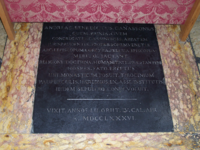 | |
| Churches with Assessed Artifacts | 74 |
|---|---|
| Total Number of Artifacts | 2221 |
| Number of Tombs | 1724 |
| Number of Plaques | 497 |
The artwork in Venetian churches is not limited to sculptures and paintings displayed at eye level on the walls , but many artifacts are found below eye level, in the floors of churches. Venetians used every surface available to decorate all aspects of their lives, including the ground they walked on. In the floors of Venetian churches, several types of artifacts can be found; one of the more common artifacts is a tombstone, marking a Venetian’s final resting place. These markers are left from when burials were still allowed inside city centers and usually contain the individual’s full name, date of birth and date of death. Other information, such as the person’s occupation, can be found on some of the more elaborate pieces. Additionally, plaques are inlayed in church floors which contain information about important events, such as the beginning of construction or prominent contributors. Many of the artifacts in the church floors are carved into tiles, usually marble or limestone, to match the surrounding floor pattern. Different color marbles, such as red, white or black, were used to set the markers apart from the rest of the floor while still keeping a uniform appearance throughout the church.[1]
Churches with Artifacts
The map below shows the churches of Venice, excluding the Lagoon islands, represented as vertical bars, where the height of each church building corresponding to the number of floor artifacts found in its floor. For example, the tallest bar on the graph corresponds to the Church of San Zanipolo (Santi Giovanni e Paolo) in Castello which has 207 church floor artifacts. [2]
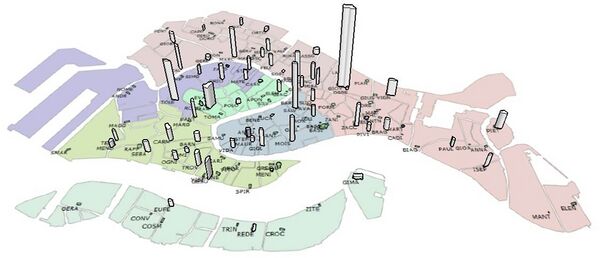
Artifact Descriptions
There are two types of artifacts found in the floors of Venetian churches: tombs and plaques. The difference between tombs and plaques is described on the Church Floor Artifact page. Below are examples of both types of artifacts.[3]
-
Example of a small tomb
-
Example of a plaque
Artifact Preservation
La Soprintendenza is a branch of the Ministry of Heritage and Cultural Activities, an Italian government organization that oversees all restoration efforts involving culturally significant artifacts across Italy. They have isolated four categories of culturally significant artifacts including archives, monuments, works of art and archeology. If a building, monument, or piece of art is in one of these categories, the Soprintendenza dictates all restoration projects that the item may undergo, regardless of if the item is publicly or privately owned. Church floor artifacts are categorized as monuments, and therefore receive preservation funds from the Soprintendenza. Typically, several small projects are carried out each year, such as cleaning a façade or replacing a roof a church, in Venice alone, even though the Soprintendenza is responsible for all of Italy. The majority of their funding comes from tax donations call the octo mille. This donation takes an additional 0.008% of your taxes and applies the money towards restoration projects for various churches across Italy. [4]
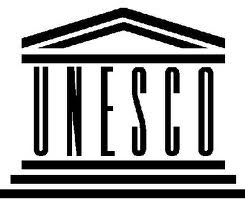
The United Nations Educational, Scientific, and Cultural Organization, UNESCO, is a second platform for providing funding to restore churches. Around the globe, there are nearly twenty private organizations dedicated to funding preservation projects for Venice. Annually, UNESCO sends these organizations the Soprintendenza’s request list to determine which projects they will be funding for the following year. After their decision has been made, they make a donation to UNESCO in order for their desired project to be carried out. UNESCO serves as the middle man, handling the paperwork and observing the logistics of the restoration processes onsite. Worcester Polytechnic Institute project teams have worked tangent to UNESCO to catalog the progress of these restoration projects, and make a record of all the artifacts that lie within the islands of Venice.[5]
Statistical Data
Many churches have been rebuilt or undergone extensive renovations since they were first constructed. A common aspect of renovation was to raise the floor of the church, but either removing the old floor, or building on top of it. It stands to reason that these new floors would contain fewer artifacts, as they have not been in the church for as many years, and therefore would not contain as many artifacts. A weak correlation exists between the elevation of Venetian church floors the number of artifacts contained in them, as evident in the graph below. The red bars correspond to the number of artifacts in each church, while the blue line represents the floor height of that particular church. You can see as the blue line increases across the graph, the number of artifacts per church appears to decrease slightly. Further analysis of when these floors were renovated might provide more insight as to a stronger correlation.
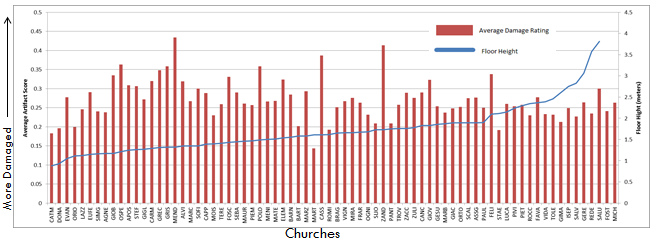
Stuff about artifact condition


Map
There are 74 churches in the city of Venice that have assessed church floor artifacts, 6 of which are located on the Lagoon islands. The yellow dots represent churches that contain floor artifacts, while the black dots represent either churches that are known to no have artifacts, or floors that could not be viewed to know if artifacts are present in their floors.[6]
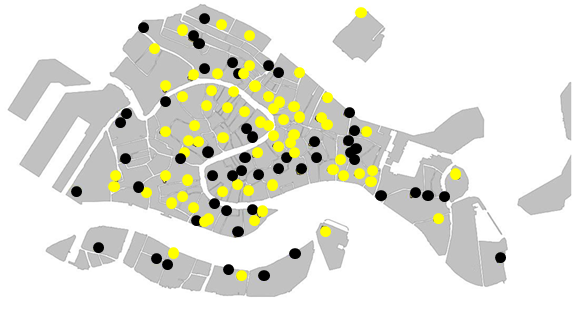
See Also
References
- ↑ Dechaine, Danielle, Hennessey, Meghan, Orszulak, Jeffrey, Rullmann, Kevin. Treasures Underfoot: Preserving Venice's Church Floor Artifacts. An Interactive Qualifying Project for Worcester Polytechnic Institute. 2012.
- ↑ Gagnon, Davidm Thompson, Kelly, Ruscitti, Eric. Embedded Heritage: A Study of Venetian Church Floors. An Interactive Qualifying Project for Worcester Polytechnic Institute. 2005.
- ↑ Dechaine, Danielle, Hennessey, Meghan, Orszulak, Jeffrey, Rullmann, Kevin. Treasures Underfoot: Preserving Venice's Church Floor Artifacts. An Interactive Qualifying Project for Worcester Polytechnic Institute. 2012.
- ↑ Soprintendenza B.A.P. di Venezia e Laguna. 2012. 7 Oct 2012 <http://www.soprintendenza.venezia.beniculturali.it/>
- ↑ UNESCO-ROSTE. " Historical Facts: Introductory Notes about the Regional Bureau for Science in Europe Starting from the Disastrous Flooding of 1966 Till Today." , accessed September 8, 2012.
- ↑ Dechaine, Danielle, Hennessey, Meghan, Orszulak, Jeffrey, Rullmann, Kevin. Treasures Underfoot: Preserving Venice's Church Floor Artifacts. An Interactive Qualifying Project for Worcester Polytechnic Institute. 2012.
Bibliography
Dechaine, Danielle, Hennessey, Meghan, Orszulak, Jeffrey, Rullmann, Kevin. Treasures Underfoot: Preserving Venice's Church Floor Artifacts. An Interactive Qualifying Project for Worcester Polytechnic Institute. 2012.
S. Hoey, M. Kahan, P Marchetti, K Mazza. Convents, Palaces and Churches: Transformation of Historic Buildings and the Impact on Venice’s Neighborhoods. An Interactive Qualifying Project for Worcester Polytechnic Institute. 2003.
Santos,Luiz G., Petrowski,Craig Peter, Kristant,Elaine Hazel, Delaive,Amanda Leigh. The Church Floors in Venice, Italy -- an Archeological Study and Analysis. An Interactive Qualifying Project for Worcester Polytechnic Institute. 2002.
External Links
http://en.wikipedia.org/wiki/Chorus_Association

